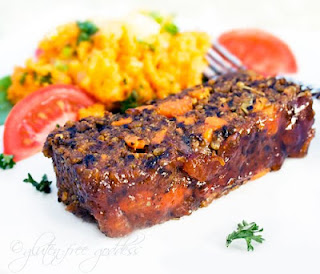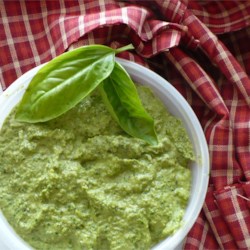
Ingredients:
Extra virgin olive oil
1 cup chopped onion- red or sweet
2 heaping cups chopped Baby Bella or Cremini mushrooms
2 cloves garlic, minced
1 tablespoon balsamic vinegar
5 cups loosely packed baby spinach leaves
Sea salt and ground pepper
1 cup cooked quinoa

1 cup toasted gluten-free bread or waffle crumbs
2 tablespoons Annie's Organic Ketchup

2 tablespoons molasses
1 tablespoon good olive oil
1 tablespoon dried Italian Herb Mix- basil, thyme, oregano, parsley, marjoram
1 teaspoon fresh minced rosemary
3-4 scallions (spring onions) sliced thin, white to light green section
1 baked sweet potato, peeled, diced (take it out before it's cooked too much, not too soft)
Maple Apricot Glaze:
1/4 cup no-sugar apricot fruit spread
1 tablespoon balsamic vinegar
1 tablespoon maple syrup
A sprinkle of cinnamon and cumin
Hot red chili flakes, to taste
Instructions:
Preheat the oven to 350ºF. Lightly oil a glass bread loaf pan

.
Or-- my latest tip is to line the bottom of the pan with a piece of parchment paper that extends up above the longer sides. When the loaf has baked, and set a bit, lift out the loaf in one whole piece.
Heat the olive oil in a skillet and cook the onion until it is translucent. Add the mushrooms and garlic; stir until softened. Add the balsamic vinegar and stir. Add the spinach. Season with sea salt and ground pepper. Stir and cook down until the mixture is soft- about seven minutes or so.
Spoon the skillet vegetables into a food processor bowl and pulse to make a grainy mixture. Don't over-process it, you want some texture.
Dump the mixture into a large bowl. Add the cooked quinoa, gluten-free breadcrumbs, ketchup, molasses and olive oil and stir to combine. Add in your dried herbs, rosemary, scallions, and mix to distribute. You want a moist mixture that sticks together when you press it with a spoon. if you need more ketchup to hold it together, add it now, maybe a tablespoon.
Last- add in the diced sweet potato and fold in gently.
Spoon the loaf mixture into the oiled loaf pan and shape it with moist fingers, pressing it tight into the pan. Smooth the top.

Make your glaze.
Pour the glaze all over the top of the loaf.
Tent loosely with a piece of foil. Bake in the center of a preheated oven until heated through and the edges of the glaze are bubbling- about 25 to 30 minutes.
Allow the loaf to set for ten minutes, tented with foil. This helps it to settle, and makes it easier to slice. Slice into portions and lift out with thin spatula. It should hold together.
Makes six slices.
Wrap and store leftovers in the fridge.
Read more:
http://glutenfreegoddess.blogspot.com/2009/05/garden-loaf-with-maple-apricot-glaze.html#ixzz1ypX2xH8r





























